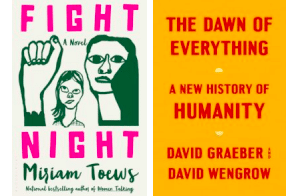The Lit Hub Staff Picks the Best Books of the Year
We have entered the month of December, and therefore, everyone who lives and works on the internet is contractually obligated to tell you which books published in the last twelve months were their favorites. Alas, Literary Hub is no exception—but at least we collectively read a lot of good books this year. (Would you like to know about the older books we liked that we read in 2021? We’ve got a list for that too.) Read on for our favorites—which we heartily recommend for all your last-minute gifting, Omicron hibernation companionship, and holiday reading needs.
*
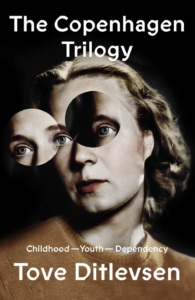
Tove Ditlevsen, The Copenhagen Trilogy
(Farrar, Straus and Giroux)
January was abuzz with these short novel-like-memoirs from Danish writer Tove Ditlevsen and for good reason: Ditlevsen’s cool intensity across these three books (Childhood, Youth, and Dependency) is utterly absorbing. As in the best of contemporary autofiction, Ditlevsen’s childhood is difficult, adults are idiotic and seemingly cruel, and she’s unbelievably wise (“The world doesn’t count me as anything…” she writes in Childhood.) Her difficult and politically volatile Youth (fascism, etc) coincides with her desire to be a writer and her early publication. In the last book, she becomes what she always imaged she would be—a writer, albeit frustrated, plus she’s addicted to Demerol and abused by her husband. Written with unflinching honestly, these are some of the most beautiful and hardest-to-read passages about addiction that I’ve ever come across. –Emily Firetog, Deputy Editor

Lisa Taddeo, Animal
(Avid Reader Press)
“I drove myself out of New York City where a man shot himself in front of me.” So begins Lisa Taddeo’s hypnotic, visceral novel about power, consent, and the cruelties of men. Joan, who has a history of dating emotionally unavailable partners, decides to rent a house in California’s mountain community of Topanga Canyon. However, in her attempt to outrun and outwit her trauma, Joan finds herself repeating old patterns. She starts a sexual relationship with 22-year-old River and befriends—or at least learns to tolerate— her grief-stricken, lecherous landlord Leonard. Yet in the grand scheme of things, these men are merely distractions. Joan has really left Manhattan behind to track down Alice, a beautiful yoga teacher who is a link to her former life. Joan is not meant to be a “likable” character. She describes herself as “depraved,” and expresses anger at the fact that people have called her a “sociopath.”
In fact, Joan thinks of herself as the total opposite—she is a woman who feels too much, who is swayed by the hot-blooded force of emotion. Violence is a recurring theme throughout the narrative and isn’t limited to physical acts of aggression. Joan’s bleak worldview depicts womanhood as a burden and female sexuality as an insatiable demon. By the end of the novel, Joan is not necessarily a brand-new person, but she has embraced the limitless abyss of her pain. This sense of understanding allows Joan to reclaim her narrative and reassess the self-made mythology surrounding her parents’ death. She may not be healed, but she is no longer afraid. Animal digs its claws into readers from the first sentence and refuses to let go until every ugly, dark secret has been laid bare. –Vanessa Willoughby, Assistant Editor
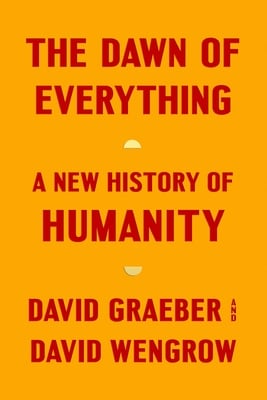
David Graeber and David Wengrow, The Dawn of Everything
(FSG)
Whether or not you’re a longtime fan of the late anarchist anthropologist David Graeber’s engagingly erudite examinations of social phenomena like debt or bullshit jobs (conveniently titled Debt and Bullshit Jobs), you will absolutely love The Dawn of Everything. Co-written with archeologist David Wengrow, DoE is a peripatetic survey of early humanity’s wide and varied attempts to organize itself, calling into question academic orthodoxies that so often treat human history as a straight narrative line that leads directly to late-stage, neoliberal capitalism. As if we didn’t make all this shit up and can’t make up some new, better shit.
From the seasonally migratory communities of the Fertile Crescent to the egalitarian foragers of 10th-century California to the proto-cities of the ancient Ukrainian steppe, DoE is a probing look back at the ways in which people—just like us!—have tried to live together (spoiler alert: heavily policed, top-down hierarchies are not inevitable systems for human coexistence). DoE is a work of history, but also offers us a way forward: we are the ones who have imagined this world into being, and maybe we can imagine our way out. –Jonny Diamond, Lit Hub Editor in Chief
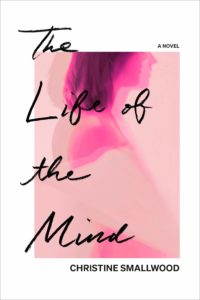
Christine Smallwood, The Life of the Mind
(Hogarth)
One of the purest pleasures I can experience while reading novels is also one of the rarest: when I read some detail—a character’s passing thought or observation, a way of relating one thing to another—that is deeply comprehensible, even familiar, despite the fact that I have never heard anyone say it out loud (or on the page) before. More plainly: I love it when characters in novels think the same terrible things that I think. This happens a lot in Smallwood’s precise debut The Life of the Mind, which is harrowing in some parts and hilarious in others, which is both deliciously cerebral and relentlessly physical, and which feels like a new kind of campus novel—one that’s actually honest. –Emily Temple, Managing Editor
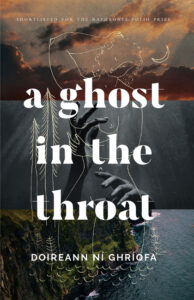
Doireann Ní Ghríofa, A Ghost in the Throat
(Biblioasis)
This is a female text, which is also a caoineadh: a dirge and a drudge song, an anthem of praise, a chant and a keen, a lament and an echo, a chorus and a hymn. Join in. So begins A Ghost in the Throat, Irish poet Doireann Ní Ghríofa’s extraordinary debut work of prose, which blends memoir, literary investigation, and autofiction to create something wholly unique and utterly bewitching. In 18th-century Ireland, a pregnant noblewoman named Eibhlin Dubh Ní Chonaill arrived at the scene of her husband’s murder and drank handfuls of his blood as he lay dying. She then composed an epic Irish language poem, “Caoineadh Airt Ui Laoghaire”—an ode to her slain beloved. 250 years later, Ní Ghríofa, a mother of four children under the age of six, commits herself to translating the poem and excavating the long-lost details of Ní Chonaill’s life. The result is mesmeric journey into the lives of two remarkable women—their art, suffering, sacrifices, ecstasies, transcendence—bound together across time. –Dan Sheehan, Book Marks Editor in Chief
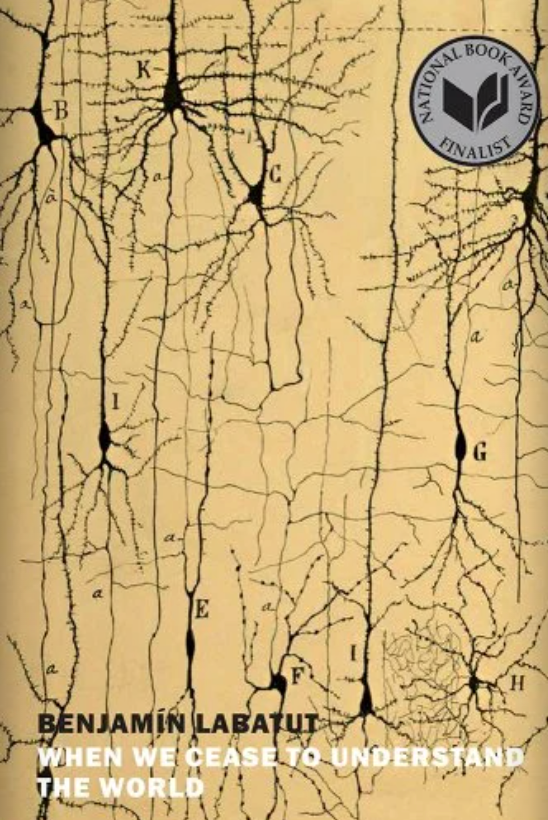
Benjamin Labatut, When We Cease to Understand the World
(NYRB)
It is safe to say this might be the “word of mouth” breakout success of the year (not often does a translated, genre-defying, contemporary NYRB title break into the New York Times 10 Best of the Year). Translated from the Spanish (Labatut is Chilean) by Adrian Nathan West, reading the first few paragraphs of When We Cease to Understand the World is like encountering a new intoxicant, with all its attendant thrills and shivers—and the uncertainty about where, exactly, things might lead.
In what is essentially a fictionalized account of the real lives of a miscellany of 20th-century scientific giants (some famous, some less so), Labatut wades through the murky waters of human genius, finding there the darker implications of discovery, for society and scientist alike. Reading the inner lives of the likes of Fritz Haber, Werner Heisenberg, and Erwin Schrödinger—rendered by Labatut with the same kind of metaphorical heuristic so often employed to reveal truths about theoretical physics—one is left almost breathless by the grim consequences of all our endless wonder. There’s a reason this hybrid novel-biography has left its mark on nearly everyone who’s taken a taste. –JD
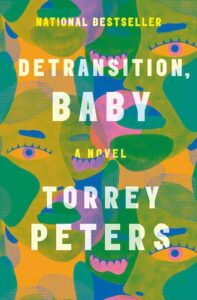
Torrey Peters, Detransition, Baby
(One World)
Because I spend too much time on the literary internet, I have developed a mild intolerance to much-hyped books. The more ubiquitously raved about a book is, the less inclined I am to read it. In the case of Detransition, Baby, my reticence was unjustified. I am delighted to add to the chorus of raves. Torrey Peters’ debut follows three characters—Reese, a trans woman who longs to be a mother; her ex, Ames, who is trans but no longer does trans, and lives as a man; and Katrina, Ames’ boss who becomes pregnant with his child—as they attempt to construct a queer parenting triad. Peters’ characters are so engaging that the premise serves mostly to give them room to exist (and in fact the flashback scenes were my favorites), and her prose is sharp and alive and very, very funny. Detransition, Baby was a blast to read, and I suspect Peters’ compassionate, nuanced portrayals of womanhood and identity will remain with me for a long time. In short: believe the hype. –Jessie Gaynor, Senior Editor
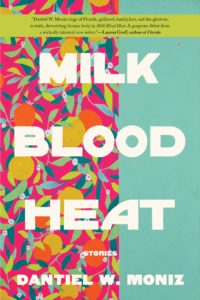
Dantiel W. Moniz, Milk Blood Heat
(Grove Press)
Dantiel W. Moniz’s Milk Blood Heat was the first book I read in 2021, and its stories have stayed with me through the year. It’s honestly one of the best collections I’ve read in a long time. Each character teeters on their own personal precipice. In the titular short story, a teenager ruminates on her relationship with her white best friend when a tragedy strikes. In “Tongues,” in a nod to The Scarlet Letter, a young woman is vilified by her religious town for refusing the inappropriate advances of the pastor. Milk Blood Heat is such a perfect name for this collection. It hints at a few threads—motherhood, family, violence—set amidst a burning Floridian landscape. There is urgency here.
Moniz gives body to the amorphous themes of literary fiction. This is a collection composed of viscera. (In “Feast,” a mother is haunted by the body parts of her unborn child.) Life’s injustices—small and large and particularly directed at young Black women—seep into the pages of these stories. But there is joy, too. In “The Hearts of Our Enemies,” readers might recognize the familiar plight of the smelly-school-lunch. A peer tells her that her meal resembles body parts, which she parrots to her mother, who gleefully responds, “But they are! […] And if anyone bothers you, you tell them, ‘In my house, we eat the hearts of our enemies.’” Don’t you just love that? Don’t you wish you had had that courage as a kid? In “Outside the Raft,” a nine-year-old thinks of the summer spent with her cousin: “We spoke a secret language, and we always understood each other.” That inseparable bond buoys the story. Together, they wonder about their shared fate: “We wondered why we weren’t born silver-scaled fish, instead of black girls with brown eyes and stick insect legs.” In a later passage, they stick their hands out of a moving car and are described as “eagles after all.” That’s the thing about Moniz’s writing: the characters occupy so many planes of existence. There is always the magic sliver of possibility lingering. Her sentences crackle and surprise; the language and everything inside it feels alive and new. –Katie Yee, Book Marks Associate Editor
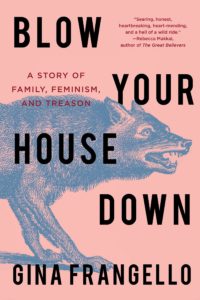
Gina Frangello, Blow Your House Down
(Counterpoint)
I’ve never been a fan of describing memoirs as “confessional” (hello, casual misogyny!), but I’ll allow for its use as a noun here—that is, the place where confession is delivered and received. I felt the weight of that exchange while communing with Gina Frangello’s memoir, ostensibly a story about infidelity (and the very real pain it can wreak on a family), but more deeply about violence and rage, girlhood and loss, and the monumental task of reclaiming one’s life. –Eliza Smith, Audience Development Editor
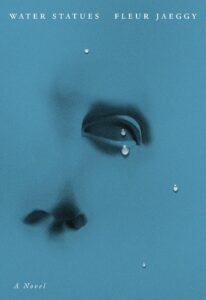
Fleur Jaeggy, tr. Gini Alhadeff, The Water Statues
(New Directions)
Part novella, part play, all water. Jaeggy’s most book to be translated into English begins with Beeklam and the statues he keeps in his villa’s flooded basement, and quickly unravels to a band of characters more connected to the villa than they are to each other. They spend their days looking out toward the sea, monologuing about broken family bonds, and loss and wreckage. It’s one of those books that asks you to plunge not quite into the plot, but the language—the way it moves and structures itself throughout. If the book’s binding element is the villa, then each sentence feels like a room; in texture and in dimension, Jaeggy’s sentences are capacious and opulent. She writes, “In the summer, the landscape was bright, even cheerful; but from September to March, at sunset, with strong winds and gurgling waves washing along the mossy floor, the place conjured only dead sailors and shipwrecks.” And lurking underneath it all is the sense of something ominous—you almost expect it to erupt and splash across the page, but it never does. Instead, it pulls you along toward the end, and entices you to start again from the beginning. –Snigdha Koirala, Editorial Fellow
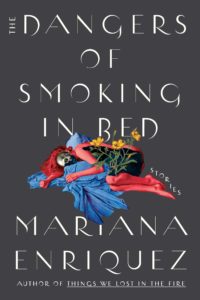
Mariana Enriquez, tr. Megan McDowell, The Dangers of Smoking In Bed
(Hogarth)
Mariana Enríquez’s newly translated 2009 collection is sometimes surreal, sometimes grittily realistic, but always unsettling. These stories catalog the consequences of repression: repressed resentment, repressed trauma, repressed history of political violence. Rotting babies crawling out of backyards, women getting horny for the human heart; there’s enough here to please genre enthusiasts. But Enríquez would say that some of the horror present in her stories is more everyday than invention: “Readers get horrified when they read one of my stories, with a child that lives in the streets, for example, but the truth is that they see children like that everyday. Many of them, sleeping in doorways, hungry, filthy,” Enríquez told Lit Hub. “But when they read it, they ask how can I go so far. The truth is, I don’t go far at all.” –Walker Caplan, Staff Writer
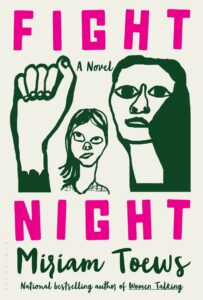
Miriam Toews, Fight Night
(Bloomsbury)
Honest to God, I do not know how Miriam Toews does it. She’s back with another stunner of a novel in the same universe as All My Puny Sorrows—that is, Miriam Toews’ lived universe of complicated, joyful, dark, hilarious, and resolutely strong women. When I first read All My Puny Sorrows, it struck me as the book of her life, and thus, impossible to follow. (In this list I also write about Claire Vaye Watkins’ I Love You But I’ve Chosen Darkness, which feels like another book of this kind. Watkins gets to the heart of what this means by referring to her “big gnar,” as in, the gaping wound of her life, the loss of her mother, around which much of the novel revolves. For Toews, her wound is the loss of her sister and father to suicide.)
But Toews has not said all there is to say, even in the perfect All My Puny Sorrows. Fight Night is told from the perspective of a nine-year old girl, Swiv, who lives with her mother and grandmother, Elvira. Her mother is pregnant, and angry, prone to outbursts and tears, and her grandmother is aging, and hilarious, and is Swiv’s partner in crime, home-school teacher, and constant companion. Elvira may not know much about, say, math, but what she does know is how to find joy in the face of unspeakable grief. In both books, AMPS and Fight Night, Toews manages an impossible balance of comedy and tragedy. In both, there is a member of the narrator’s family whose longing for death defines their whole life. Life can be dark for us all at times, but Toews puts it all into perspective. And what is most remarkable about this universe is that Toews can always see the light through the darkness, and with grace and tenderness and humor, tells how to live with it, really live. –Julia Hass, Contributing Editor

Francine Prose, The Vixen
(Harper)
A literary caper is a rare and beautiful thing, and The Vixen is a splendid one. Simon Putnam, a (dubiously) up-and-coming young editorial assistant in Cold War-era New York is given the daunting—both morally and editorially—task of making a tasteless, terrible potboiler about the exploits of sexy spies “Esther and Junius Rosenstein” slightly less terrible. (The novel opens on the executions of the real Ethel and Julius Rosenberg, which Simon watches with his parents from their Coney Island living room.) As befits a story that orbits spies, Simon begins to suspect that the motives of his colleagues are not as they seemed, and Prose rolls out every twist with relish (though perhaps not quite as much relish as she reserves for the excerpts of the potboiler, which are delightfully awful). –JG
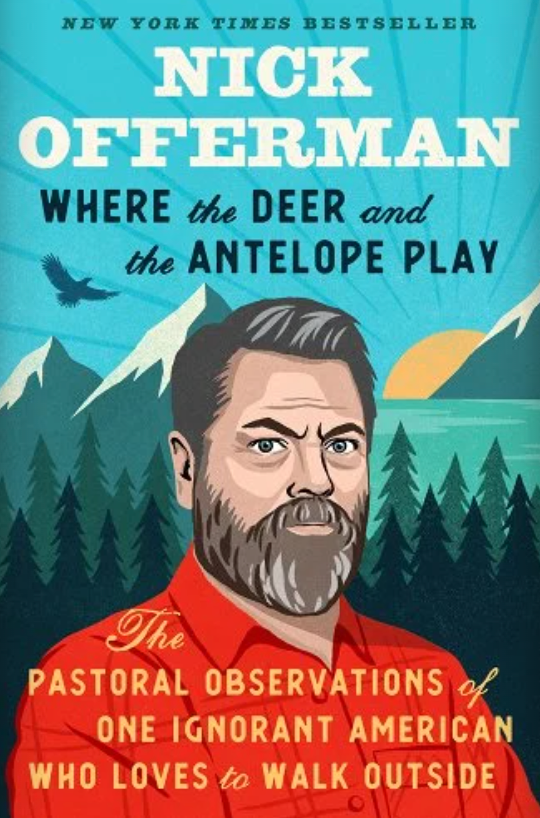
Nick Offerman, Where the Deer and the Antelope Play
(Dutton)
I have always deeply enjoyed Nick Offerman. Whether as the gruff, lovable Ron Swanson on Parks & Rec, or as the handy co-host of Making It, his wry and deadly Midwestern comic temperament is right after my own air-dried heart. And yet, as a (self-)important man of contemporary letters (lol), I was skeptical about Offerman’s essayistic memoir, Where the Deer and the Antelope Play, which is billed as “the pastoral observations of one ignorant American who likes to walk outside.” Fuck was I wrong. Structured in three parts, Offerman’s broader project seems to be reconciling what we think of as old-fashioned American virtues—manual labor, working the land, “freedom”—with the frequently toxic ways they manifest as a subset of contemporary masculinity.
Despite the fact I am 100 percent the target audience for this book (I own a router, I like the woods, I am an old labor lefty), I was nonetheless surprised at how deep Offerman goes on the source material behind the ideas he’s trying to unpack. Not only do we get thoughtful readings of old favorites like Aldo Leopold and Wendell Berry, but Offerman introduces the writing of Indigenous Australian Bruce Pascoe to the mix, whose 2014 Dark Emu should be required reading for any settler-colonial society (also, Mr. Offerman—Nick, if I may—I highly recommend Robin Wall Kimmerer and David Treuer, if you haven’t already read them).
Most of the above comes in the second section of the book’s three parts, in which Offerman shamelessly attempts to join the family of beloved Cumbrian writer-shepherd James Rebanks. The first section, with genial echoes of Edward Abbey, is built around a hike through Glacier National Park with George Saunders and Jeff Tweedy, and has already entered the contemporary Dad Rock canon; the final section follows Offerman and his wife Megan Mullaly as they pilot around America in an RV during a pandemic, meeting a wide assortment of people just trying to get from one end of the day to the other. But this is no Gen X Garrison Keillor bullshit: Offerman is a real social critic, balancing a deeply humane capacity for nuance with a moral rigor that demands we call out evil as we see it. For grumpy uncles everywhere. –JD
More

